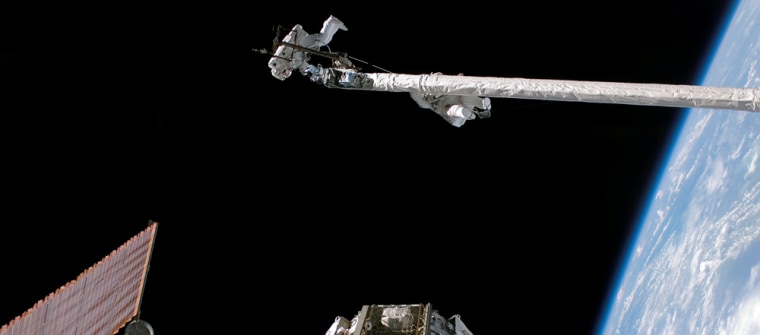It’s a junkyard out there in space, and sometimes astronauts accidentally contribute to the litter.
In 1965, the first American spacewalker, Ed White, lost a spare glove when he went outside for the first time. From that time on, astronauts have accidentally added some of the more unusual items to the 100,000 pieces of space trash that circle Earth.
Last July, spacewalker Piers Sellers sheepishly reported that he lost a spatula. Nicknamed “spatsat” by space junk watchers, it returns to Earth in a fireball early next month. This week the Atlantis astronauts made their own contributions to the space debris in low orbit: a couple of bolts that escaped from the addition they were connecting to the international space station.
To engineers, this isn’t funny. Many of those pieces of space junk can kill astronauts, puncture satellites or at the very least scratch up expensive space shuttle windows.
“It’s one of these problems that is growing in seriousness,” said William Ailor, director of the Center for Orbital and Re-entry Debris Studies at The Aerospace Corp. in Los Angeles. “It’s really the small things that will get you.”
Thousands of objects
Using radar and telescope sensors, NASA and the Air Force track objects bigger than about 4 inches (10 centimeters). The official “box score” of that space debris as of Thursday was 9,925. But the 90,000 objects smaller than that can be as dangerous, zipping around Earth at more than 15,000 mph (24,000 kilometers per hour). They are just harder to track.
NASA has even seen debris hits of dried-up urine, toothpaste, and shaving cream — all from space shuttle waste dumps — in an experiment placed outside of the Russian space station Mir, said officials at the NASA orbital debris program lab. An Indonesian satellite was struck by urine and fecal matter. Now NASA doesn’t dump human waste outside much anymore.
Of all the items followed by the Air Force, the more unusual ones are those “that aren’t necessarily meant to drop,” said Air Force Space Protection Officer David Ward of the First Space Control Squadron in Cheyenne Mountain. “The astronauts didn’t necessarily mean to let go of the bolts the last couple days, but that happens.”
So when spacewalkers venture outside, NASA makes sure everything is tethered — tools, bolts, the astronauts themselves. Think of it as wrapping a Christmas present with everything tied up to something, the scissors, the paper, the scraps of paper not used, said NASA spokesman Phil West, a former spacewalk tool engineer.
“You worry about (losing tools) all the time,” said former astronaut and spacewalker Jay Apt, noting that he never lost anything.
And well they should worry.
Junk can kill, or spark a lawsuit
Not only can space junk damage or kill, you can get sued, too. There are lawyers who monitor space junk because there’s a complex legal treaty about who is responsible when the human-made debris cripples a satellite worth hundreds of millions of dollars, said Mark Matney, a scientist in the orbital debris program at Johnson Space Center.
In the 1960s, America launched bunches of copper needles into Earth’s orbit in an ill-conceived plan for post-nuclear war communications, Matney said. Many of those needles are still up there. Other purposely jettisoned space junk once included bags of trash thrown overboard from the Russian space station Mir and pieces of equipment pitched into orbit from spacewalkers fixing the Hubble Space Telescope.
Slideshow 12 photos
Month in Space: January 2014
“I guess it’s a junkyard; most of the problems are little things that cause dings, like your car, I guess,” Matney said. Even an object the size of a medicine tablet “will do a significant amount of damage to most spacecraft.”
And there are much bigger objects to worry about, including giant rocket bodies from launches dating back more than 40 years. But those are often in the most hazardous area for space junk, which is about 400 miles (640 kilometers) above the space station and shuttle, Matney said.
Ask Matney what the biggest piece of space junk in orbit now is and he quickly says it is the international space station. The astronauts living aboard the orbiting lab may not think of it as junk, but to Matney “every spacecraft is destined to become debris.”

